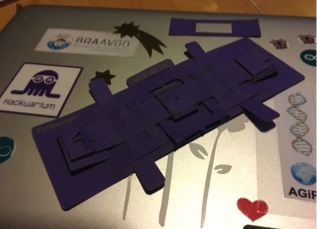Hi Rachel
I’m going to respond to the question in your subject line, but not be very useful with how to encourage increased sharing! Maybe someone else can chip in who has had experience making the case to a company to share their designs (and the rights to use them).
The PLOS paper was open access but you’re right, Foldscope has never been open hardware and afaik no original design files for any version have been released (am I right about that?).
It’s also covered by a granted US patent and a pending application with the European patent office, plus there’s a separate granted US patent for manufacturing the lenses:
US20180003937A1: Optical Device
US9810892B2: Optical lens fabrication
They’re all owned by Stanford University. This may be part of a longer term strategy to make them open hardware but there is no indication anywhere of open licensing, patent pledging or an intent to drop the patent, which can be a strategic way to get things in to the public domain and discoverable as prior art if you can afford the initial filing.
Patents are geographically restricted so outside of Europe and the US there is nothing published that would restrict any sort of use (caveat: something may been filed but not published yet). Most European countries view patents as more or less restricted to exclusive rights for commercial use so usually for personal, research and non-commercial uses you’re fine (another caveat: I am not a lawyer and non-commercial is an unclear term). Unfortunately US patent law is very strict and forbids anyone from making, using or selling the invention, even when the use is strictly personal. The patent owners may not care about particular types of infringement so this may not present a problem to use of DIY scopes by citizen scientists in the US, but it doesn’t have the legal clarity of knowing something is open hardware.
In answer to your question as to what is open access, a frequent conversation I have with people is the difference between open access to papers, for which I use the Budapest Open Access Initiative definition (BOAI):
By “open access” to this literature, we mean its free availability on the public internet, permitting any users to read, download, copy, distribute, print, search, or link to the full texts of these articles, crawl them for indexing, pass them as data to software, or use them for any other lawful purpose, without financial, legal, or technical barriers other than those inseparable from gaining access to the internet itself. The only constraint on reproduction and distribution, and the only role for copyright in this domain, should be to give authors control over the integrity of their work and the right to be properly acknowledged and cited.
and open hardware, for which I use the OSHWA definition:
Open source hardware is hardware whose design is made publicly available so that anyone can study, modify, distribute, make, and sell the design or hardware based on that design. The hardware’s source, the design from which it is made, is available in the preferred format for making modifications to it. Ideally, open source hardware uses readily-available components and materials, standard processes, open infrastructure, unrestricted content, and open-source design tools to maximize the ability of individuals to make and use hardware. Open source hardware gives people the freedom to control their technology while sharing knowledge and encouraging commerce through the open exchange of designs.
My take on this is that you can publish an open access paper for which the data, software, hardware and any other research outputs that is describes are closed. That doesn’t stop the paper being open access but it does mean it isn’t embodying all of the aspects of open science/open research that it might do.
I always encourage people to be explicit with what they mean by ‘Open X’ or it gets very confusing! For example, Open Access is applied to far more than the BOAI-compliant levels of openness. A good resource for the spectrum of practices in access to journals is the PLOS ‘How Open Is It?’ guide.
Good luck with your discussions and the workshop!
Jenny


